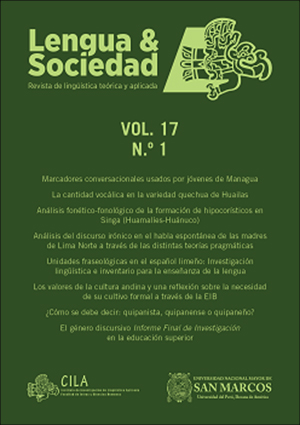Vocal Quantity in the Quechua Variety of Huailas
DOI:
https://doi.org/10.15381/lengsoc.v17i1.22361Keywords:
Generative phonology, trait subspecification, moraic theory, syllable, trait matrix, quechua huailasAbstract
Based on the application of the theoretical postulates of generative phonology, specifically of autosegmental phonology, in this investigation, phonological phenomena related to the existing vowel quantity in Quechua of the variety Huailas, belonging to the dialect Huáilay, spoken in the provinces of Caraz, Carhuaz, Yungay and Huaraz, located in the department of Áncash, Peru, are described and explained in synchronous terms.
References
Adelaar, W. F. H. (1984). Grammatical vowel length and the classification of quechua dialects. International Journal of American Linguistics, 50(1), 25-47.
Archangeli, D. (1988). Aspects of Underspecification Theory. Phonology, 5, 183-207.
Blevins, J. (1996). The Syllable in Phonological Theory. En J. Goldsmith, The Handbook of Phonology Theory (pp. 206-244).
Brosellow, E. (1996). Skeletal Positions and Moras. En J. Goldsmith, The Handbook of Phonology Theory (pp. 175-203).
CerrónPalomino, R. (1976). Diccionario quechua Junín-Huanca. Lima: Ministerio de Educación.
CerrónPalomino, R. (1987). Lingüística Quechua. Cuzco: Bartolomé de las Casas.
D’introno, F. et al. (1995). Fonética y Fonología actual del español. Madrid: Cátedra.
Goldsmith, J. (1980). Autosegmental Phonology. New York: Garland.
Hayes, B. (1989). Compensatory Lengthening in Moraic Phonology. Linguistic Inquiry, 20(2), 253-304.
Katada, F. (1990). On the representation of Moras: Evidence from a language game.Linguistic Inquiry, 21(4), 641-645.
Kenstowicz, M. (1995). Phonology in Generative Grammar. Oxford: Blackwell.
Lleó, C. (1997). La adquisición de la fonología de la primera lengua y de las lenguas extranjeras. Madrid: Visor.
Martínez-Gil, F. (1990). Redundancy and phonological rules in Spanish. The Georgetown Journal of Languages y Linguistics, 1(4), 415-452.
Moreno, J. C. (1994). Curso Universitario de Lingüística General (Tomo II). Madrid: Síntesis.
Núñez, R. (1988). Alargamiento vocálico compensatorio en el español cubano: Un análisis autosegmental. En M. Hammond & C. Resnick (eds), Studies in Caribbean Spanish Dialectology. Washington DC: Georgetown UP.
Núñez, R., & MoralesFront, A. (1998). Fonología generativa contemporánea de la lengua española. Washington DC: Georgetown University.
Núñez, R., & Morales-Front, A. (1999). Fonología generativa contemporánea de la lengua española. Washington DC: Georgetown University.
Parker, G. (1963). La clasificación genética de los dialectos quechuas. Revista del Museo Nacional, 32, 241-252.
Parker, G. (1967). Fonología y Morfofonémica del quechua de Caraz. En A. Escobar et al, Cuatro fonologías quechuas (pp. 27-40). Lima: UNMSM.
Parker, G. y Chávez, A. (1976). Diccionario quechua Ánchash-Huailas. Lima: Ministerio de Educación.
Perlmutter, D. (1996). Phonological Quantity and Multiple Association. En J. Goldsmith (Ed.), The Handbook of Phonology Theory (pp. 307-317).
Piggot, G. L. (1995). Epenthesis and Syllable Weight. Natural Language and Linguistic Theory, 13, 283-326.
Quesada, F. (1984). Fonological Processes in Quechua and their Implications for the Phonological Theory. Nueva York: Universidad Estatal de Nueva York.
Seliger, H. & Shohamy, E. (1989). Second Language Research Methods. Oxford: Oxford University.
Torero, A. (2003). Los dialectos quechuas. Fabla, 2(2), 12-61.
Weber, D. & Landerman, P. (1985). On the interpretation of Long Vowels in Quechua. International Journal of American Linguistics, 51(1), 94-108.
Downloads
Published
Issue
Section
License
Copyright (c) 2018 Carmita Pilar Vivas Bravo

This work is licensed under a Creative Commons Attribution 4.0 International License.
AUTHORS RETAIN THEIR RIGHTS
a. Authors retain their trade mark rights and patent, and also on any process or procedure described in the article.
b. Authors can submit to the journal Lengua y Sociedad, papers disseminated as pre-print in repositories. This should be made known in the cover letter.
c. Authors retain their right to share, copy, distribute, perform and publicly communicate their article (eg, to place their article in an institutional repository or publish it in a book), with an acknowledgment of its initial publication in the journal Lengua y Sociedad.
d. Authors retain theirs right to make a subsequent publication of their work, to use the article or any part thereof (eg a compilation of his papers, lecture notes, thesis, or a book), always indicating its initial publication in the journal Lengua y Sociedad (the originator of the work, journal, volume, number and date).



























